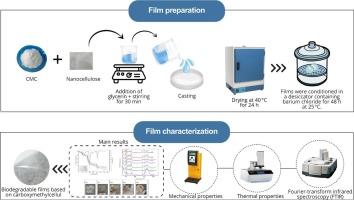桉树纳米纤维素复合羧甲基纤维素生物降解膜的研制与表征
IF 9.8
1区 农林科学
Q1 CHEMISTRY, APPLIED
引用次数: 0
摘要
可生物降解和/或可再生聚合物,如羧甲基纤维素(CMC),已经成为替代传统塑料的可持续替代品,传统塑料构成了累积环境废物的很大一部分。然而,与石油衍生聚合物相比,这些材料有一些局限性,例如水溶性高,机械性能较弱,水蒸气和氧气渗透性较低。因此,新技术,如加入纳米纤维素等纳米材料,可以帮助生产性能更好、更强的CMC材料。本研究采用浇铸法制备了桉树(eucalyptus grandis)纳米纤维素含量分别为5 %、10 %、20 %和30 %(相对于CMC质量)的CMC膜。对这些薄膜的溶解度、含水量、水蒸气渗透性、厚度、光学、机械和热性能以及生物降解性进行了评估。红外光谱显示了CMC与纳米纤维素之间的分子和化学相互作用。当纳米纤维素含量为10%和20% %时,膜的厚度、含水率和水蒸气渗透率保持不变,而溶解度有所提高。在30% %纳米纤维素薄膜中,杨氏模量提高到6791.7 MPa。所有样品表现出四个主要阶段的质量损失20 °C和61 °C, 64 °C和202 °C, 232 °C和497 °C, 499 °C和525 °C,也表现出透明的大约60 %,透明度低。进一步验证了膜的生物降解性,含纳米纤维素的膜的生物降解时间为10 d。薄膜性能的变化可以用CMC和纳米纤维素在薄膜中的化学和分子相互作用来解释。结果表明,纳米纤维素的加入有利于提高CMC膜的某些性能。本文章由计算机程序翻译,如有差异,请以英文原文为准。

Development and characterization of biodegradable films based on carboxymethylcellulose with incorporated eucalyptus (Eucalyptus grandis) nanocellulose
Biodegradable and/or renewable-source polymers, such as carboxymethylcellulose (CMC), have emerged as a sustainable alternative to replace conventional plastics, which constitute a significant portion of accumulated environmental waste. However, compared to petroleum-derived polymers, these materials have some limitations, such as high water solubility, weaker mechanical properties, and lower water vapor and oxygen permeability. Thus, new technologies, such as incorporating nanomaterials like nanocellulose, can help produce stronger CMC materials with improved properties. In this study, CMC films incorporated with eucalyptus (Eucalyptus grandis) nanocellulose at concentrations of 5 %, 10 %, 20 %, and 30 % (relative to the CMC mass) were produced using the casting method. These films were evaluated for solubility, moisture content, water vapor permeability, thickness, optical, mechanical, and thermal properties and biodegradability. FTIR spectra showed molecular and chemical interactions between CMC and nanocellulose. Thickness, moisture content and water vapor permeability remained unchanged, while solubility increased for films with 10 and 20 % of nanocellulose. Young's modulus was improved to 6791.7 MPa in the 30 % nanocellulose film. All samples exhibited four main stages of mass loss 20 °C and 61 °C, 64 °C and 202 °C, 232 °C and 497 °C, 499 °C and 525 °C and also exhibited transparency of about 60 % and low opacity. Furthermore, film ‘s biodegradability was verified and lasted 10 days for films containing nanocellulose. Changes in film properties can be explained by chemical and molecular interactions between CMC and nanocellulose in the films. It is concluded that the addition of nanocellulose is advantageous for improving some characteristics of CMC films.
求助全文
通过发布文献求助,成功后即可免费获取论文全文。
去求助
来源期刊

Food Chemistry
工程技术-食品科技
CiteScore
16.30
自引率
10.20%
发文量
3130
审稿时长
122 days
期刊介绍:
Food Chemistry publishes original research papers dealing with the advancement of the chemistry and biochemistry of foods or the analytical methods/ approach used. All papers should focus on the novelty of the research carried out.
 求助内容:
求助内容: 应助结果提醒方式:
应助结果提醒方式:


